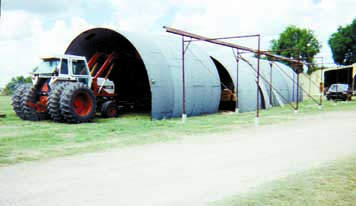Old grain bins can be converted into low-cost buildings, says Carl Miller of Brookshire, Texas, who recently showed FARM SHOW how he converted two 5,000-bu. grain bins into a 75 by 40-ft. storage shed. The quonset-type building is 18 ft. high and is divided into a 24-ft. wide middle section, with separate 10-ft. wide walled-off sections on each side. "I use it to store small square and round bales as well as machinery. It cost only a fraction as much as putting up a commercial building of a comparable size," says Miller. "I didn't need the two bins any more because I had converted my crop land to hay and pasture. However, I did need a place to store hay and keep it dry." A site was prepared for the shed, with a 4-ft. high wooden wall put up on one side and a 10-ft. high steel framework on the other. The bins were 24 ft. in dia. and 18 1/2 ft. high. A truck-mounted crane was used to lift the roof off each bin and set it on the ground. He first cut most of the bolts that held the roof panels to the side walls. In order to reduce the amount of time the rented crane had to be on the farm, he used a torch to vertically "stitch cut" the bin wall. On each side of the bin he made a 1-ft. long cut, then left 1 in. of material, then made another 1-ft. long cut, etc., leaving just enough material so that the bin would stand on its own. When the crane arrived, he removed the remaining bolts, hooked ropes onto the roof, and used the crane to lift the roof off. He then cut the 1-in. long "stitches" out of the bin walls and used the crane to lay each half down, with the cut side down, so that it could be hauled away by a loader tractor. The four bin halves were placed into position and then bolted back together. One side bolts to the 4-ft. high wood wall. Once that side was in place, three loader tractors were used to lift the other side of the building so it could be tach-welded to a 10-ft. high steel frame that supports it. The last step was to apply silicone and roof cement between the bin sections. "It worked out quite well and I'm very proud of it," says Miller. "My five employees helped me build it. We moved the bin sections about 150 yards to the shed site. I rented a crane. "I built it after I offered the bins free to anyone who would move them but didn't have any takers. I considered buying a hoop-style fabric building but then decided that I could save money by converting the bins." Miller left both ends of the middle section open for now. However, he saved the bins' perforated floors and plans to use them to close off the ends. "The perforated floors will let air circulate but keep most of the rain out," says Miller. He used some of the pie-shaped roof panels to make partial walls along the open side of the building. He simply alternated the pieces to form the rectangular walls. "To make a dry floor inside the shed, we put down a layer of left-over plastic from round silage bales and then covered it with a 6-in. thick layer of broken cement that I got free from a local manufacturer." .
1-800-834-9665
Low-Cost Buildings Made From Old Grain Bins
FARM SHOW Magazine » Low-Cost Buildings Made From Old Grain Bins
Low-Cost Buildings Made From Old Grain Bins
